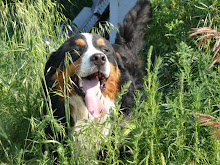Sows on a North American "factory" farm.
Pigs
Pigs are very clean animals who take to the mud primarily to cool off and evade flies.
Very true for once we agree on something.
They are just as friendly and gregarious as dogs, and according to Professor Donald Broom at the Cambridge University Veterinary School, “They have the cognitive ability to be quite sophisticated. Even more so than dogs and certainly three-year-olds.”
They are also aggressive, towards both humans and each other. Boars (males) will fight till one of the combatants dies, and sows and gilts (mothers and young females) will fight to maintain pecking order.
Mother pigs in factory farms in the U.S. live most of their lives in individual crates that are 7 feet long and 2 feet wide.
Not a perfect system, I agree, but one that is being gradually phased out in favour of loose housing.
It should be noted, however, that loose housing isn't perfect either. Pigs have a complicated social heirarchy, and will fight to maintain dominance.
Sows can be so aggressive towards each other that some smaller weaker sows become afraid to eat, drink or seek a comfortable spot to lay.
Fighting causes lameness and is also a potential source of infection, as disease causing organisms get into cuts and abrasions, compromising the health of the animal.
Sows have an exceptionally unpleasant habit of biting the vulva of their victims, causing a very painful injury which can ultimately result in death.
Fighting can also cause abortions.
Loose housing also allows for the transmission of parasites necessitating the use of deworming and mange medication.
They display signs of extreme boredom and stress, such as biting the bars of their cages and gnashing their teeth.
What rubbish. As a general rule pigs usually chew on the bars of their crate when its coming close to feeding time and they are hungry. For there most part sows are like cats and they sleep.
Their piglets are taken away three weeks after birth and packed into pens until they are singled out to be raised for breeding or for meat.
Weaning age varies worldwide from 10 to 35 days, 21 days being the norm. By this time the mother pig is glad to get away from her brood, who, having become the equivalent of teenagers are beginning to drive her nuts.
The piglets are moved to a specialised nursery room where they are.kept in groups. (large or small)
Like chickens and turkeys, pigs are genetically manipulated and pumped full of drugs, and many become crippled under their own weight.
Good grief! There you go again talking about genetic manipulation. Where do you get this nonsense? No. Nothing could be further from the truth.
Pigs are no more "pumped full of drugs" than a child who gets ear infections and takes a course of antibiotics prescribed by a doctor. Drugs for pigs have to be prescribed by a veterinarian, and what's more, they have to be paid for. As you keep pointing out, farmers want to produce their pigs at the lowest possible cost. Why would they pay for unnecessary drugs?
And that last bit about pigs being crippled under their own weight is sheer fantasy.
Although pigs are naturally affable and social animals, the confinement of these crowded pens causes neurotic behaviors such as cannibalism and tail-biting, so farmers use pliers to break off the ends of piglets’ teeth and cut off their tails without any painkillers.
Cannibalism and tailbiting are just things pigs do. They have nothing to do with confinement in a pen, crowded or otherwise.
Farmers do indeed dock pigs tails, and some farmers clip a piglets eye teeth, although this practice has been discontinued by many farmers.
Pigs are transported through all weather extremes, often freezing to the sides of transport trucks in leading pig-slaughtering states like Iowa and Nebraska or dying from dehydration in states like North Carolina.
No one would deliberately transport pigs during such weather extremes, but weather changes, and once pigs are on their way to their destination they have to keep going. Or would you like the truck driver to stop and book them all into a motel for the night?
According to the industry, more than 100,000 pigs die en route to slaughter each year, and more than 400,000 arrive crippled from the journey.
According to the industry, 109,000,000 pigs were slaughtered in the US in 2007. So according to your figures less than one in a thousand died, and less than four in a thousand arrived lame. I reckon that's a pretty good safety record.
At the slaughterhouse, improper stunning means that many hogs reach the scalding-hot water baths—which are intended to soften their skin and remove their hair—while they are still conscious.
No. Pigs are rendered unconscious instantly.
U.S. Department of Agriculture inspection records documented 14 humane slaughter violations at one processing plant, including finding hogs who “were walking and squealing after being stunned [with a stun gun] as many as four times.”
14? Out of how many million?
A PETA investigation found that workers at an Oklahoma farm were killing pigs by slamming the animals’ heads against the floor and beating them with a hammer.
Its called blunt trauma. It may not sound nice but it is a quick and painless method of euthanizing a sick or terminally injured. It's more trsaumatic for the person who has to do it than it is for the piglet
Piglet. Note. PIGLET. I defy anyone to slam the head of even a half grown pig against the floor.
Quote of the day
“Recognize meat for what it really is: the antibiotic- and pesticide-laden corpse of a tortured animal.”
Ingrid Newkirk, peta president

No comments:
Post a Comment